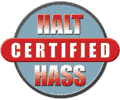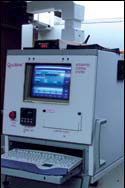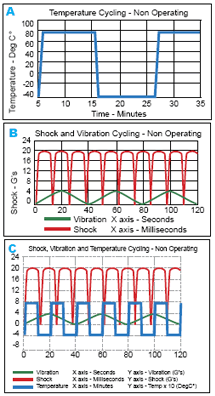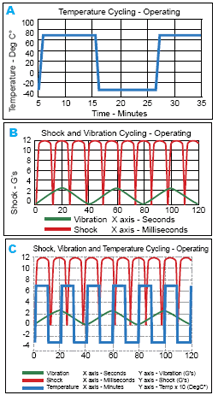 HALT/HASS Tested HALT/HASS Tested
HALT (Highly Accelerated Life Test)
HASS (Highly Accelerated Stress Screening)
|
The Ultimate Test for Reliability
The HALT test was initially conceived for testing electronic products for shuttle launch. The purpose of this test is to subject the product to a combination of high shock, vibration and a steep temperature gradient. MTBF of all electronic products depends upon the strength of connections of various components inside and therefore HALT is the ultimate test for reliability testing.
Here is how it works:
1. Initial Design Specifications
Before a product is taken to drawing board, all the desired specifications are laid out around which a product is to be designed. These specifications are based on the actual working parameters that are applied to our products in the industry. Let's pick an example of our Toughpanel and see all the steps it goes through. The published specifications for Toughpanel are shown in the column to the right.
2. HALT Test of Finished Product
Once a product is designed and built as per initial specifications, it is subjected to HALT testing. Again the point of this phase is to eliminate any pre-mature failure that might be present in its initial design. Based on the above published specifications, Toughpanel is subjected to following tests:
Without Power (Non-Operating)
A-Temperature Cycling: 20°C beyond published spec @ 100°C/min.
For Non-Operating (storage) conditions, Toughpanel goes through a total of 50 cycles of thermal shock in the range of -40˚C to +80˚C at the rate of 100˚C/min. If Toughpanel passes Temperature Cycling test, it advances to next step. If for any reason Toughpanel does not complete temperature cycling test for at least 50 cycles it goes back to drawing board for re-design and the process continues until it passes.
B-Shock and Vibration Cycling: 2 Times published spec
After Toughpanel passes Temperature Cycling test, it is subjected to Vibration and Shock test as set by internal HALT specifications of 5-55 HZ 4 G's for 2 hours maximum and 20 G's for 12 ms respectively Non-Operating (storage) conditions. If Toughpanel passes the Shock and Vibration cycling test, it advances to next step. If for any reason Toughpanel does not complete the Shock and Vibration cycling test for at least 50 cycles, it goes back to drawing board for re-design and the process continues until it passes.
C-Combined Temperature and Shock/Vibration: 20°C beyond & 2 Times Gs @ 100°C/min.
After Toughpanel passes Shock and Vibration cycling test, it is subjected to a combined Temperature, Shock, and Vibration test as set by internal HALT specifications of -40˚C to +80˚C at the rate of 100˚C/min, 5-55 HZ 4 G's for 2 hours maximum, and 20 G's for 12 ms respectively for Non-Operating (storage) conditions.
Unit Under Power, Fully Functional
(Operating)
A-Temperature Cycling: 10°C beyond published spec @ 100°C/min.
For Operating conditions, Toughpanel goes through a total of 50 cycles of thermal shock in the range of -30˚C to +70˚C at the rate of 100˚C/min. If Toughpanel passes Temperature Cycling test, it advances to next step. If for any reason Toughpanel does not complete temperature cycling test for at least 50 cycles it goes back to drawing board for re-design and the process continues until it passes.
B-Shock and Vibration Cycling: 20% beyond published spec
After Toughpanel passes Temperature Cycling test, it is subjected to Vibration and Shock test as set by internal HALT specifications of 5-55 HZ 2.4 G's for 2 hours maximum and 12 G's for 12 ms respectively Operating conditions. If Toughpanel passes the Shock and Vibration cycling test, it advances to next step. If for any reason Toughpanel does not complete the Shock and Vibration cycling test for at least 50 cycles, it goes back to drawing board for re-design and the process continues until it passes.
C-Combined Temperature and Shock/Vibration: 10°C beyond & 20% beyond published Gs @ 100°C/min.
After Toughpanel passes Shock and Vibration cycling test, it is subjected to a combined Temperature, Shock, and Vibration test as set by internal HALT specifications of -30˚C to +70˚C at the rate of 100˚C/min, 5-55 HZ 2.4 G's for 2 hours maximum, and 12 G's for 12 ms respectively for Operating conditions.
After the successful completion of both Operating and Non-Operating HALT tests within specifications, Toughpanel is released for production.
|
HASS Based Manufacturing Process
Highly Accelerated Stress Screening (HASS)
HASS is an integral part of the manufacturing process at AVG/Uticor. The main purpose of HASS testing is to ensure that our manufacturing processes are in control. 1% AQL (per Mil Spec) level samples from the end of the manufacturing line are subjected to HASS testing to qualify and re-qualify the manufacturing process. If we detect a failure in HASS testing beyond acceptable Mil Spec numbers, the entire manufacturing lot is segregated for further screening. To explain this further, lets continue with the example of Toughpanel.
The operating specification for Toughpanel is 0˚C to +45˚C with 2Gs of vibration and 10Gs of shock. 1% AQL sample of a production run will be subjected to HASS testing from -5˚C to +50˚C @ 2.2 Gs of vibration and 11 Gs of shock. Failure beyond Mil Spec number based on 1% AQL, will subject the entire lot to segregation and further analysis. |
|
| |
HALT/HASS Chamber Capability
-60˚C to 150˚C
at 100˚C/min and 50 Gs
of shock and vibration.
We invested over $500,000 in this
HALT/HASS Chamber |
 |
Toughpanel’s Published Specifications:
Storage (Non-Operating) Temperature: -20˚C to +60˚C
Operating Temperature: 0˚C to +45˚C
Vibration: 5 to 55 Hz 2 G’s for 2 hours in X, Y, and Z axis
Shock: 10 G for 12ms in the X, Y, and Z axis
Internal HALT Threshold To Achieve The Above Published Specifications:
Our internal HALT thresholds are ALWAYS higher then the
required published specifications. These thresholds for Toughpanel are as follows:
Storage Temperature: -40˚C to +80˚C
Storage (Non-Operating) Vibration: 5 to 55 Hz 4 G’s for 2 hours in X, Y, and Z axis
Storage (Non-Operating) Shock: 20G for 12ms in the X, Y, and Z axis
Operating Temperature: -10˚C to +55˚C
Operating Vibration: 5 to 55 Hz 2.4 G’s for 2 hours in X, Y, and Z axis
Operating Shock 10G for less than 12ms in the X, Y, and Z axis |
Without Power (Non-Operating)
 |
Unit Under Power, Fully Functional (Operating)
 |
|
|
